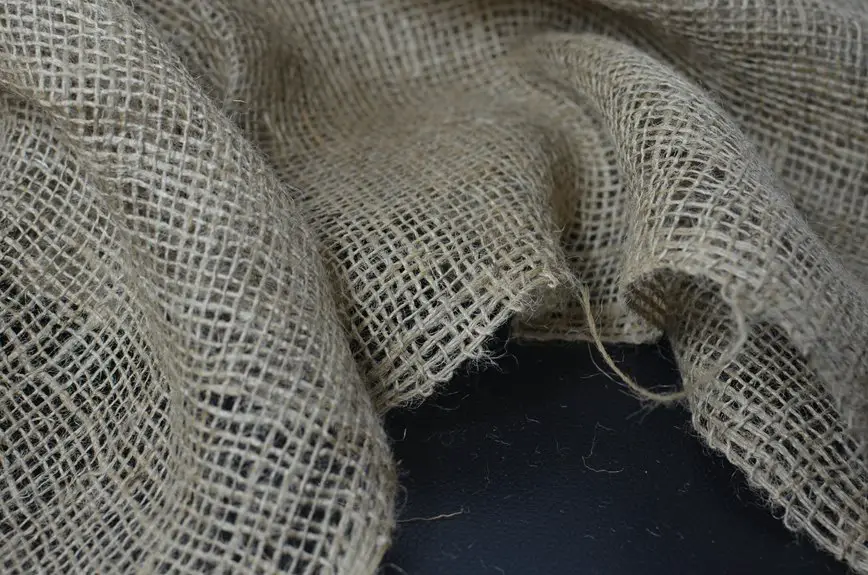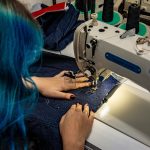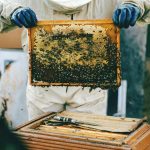Recycled polycotton is an eco-friendly fabric made by blending reclaimed cotton and polyester fibers from textile waste. It saves energy, cuts down pollution, and reduces landfill waste while keeping the durability and comfort you expect from traditional polycotton. You can find it in clothing, home textiles, and workwear, and it’s easy to care for too. If you want to understand why it’s becoming a top choice for sustainable fashion, there’s plenty more to explore.
Table of Contents
Key Takeaways
- Recycled polycotton blends recycled polyester and cotton fibers from post-consumer and industrial textile waste, promoting sustainable fabric use.
- It retains polyester’s durability and wrinkle resistance while offering cotton’s breathability and softness.
- Production saves energy and reduces CO2 emissions compared to virgin polycotton manufacturing.
- Commonly used in apparel, home textiles, and industrial fabrics, with care instructions favoring cold wash and low-heat drying.
- The fabric supports circular fashion by reducing landfill waste and encouraging garment recycling and responsible consumer behavior.
Understanding the Composition of Recycled Polycotton
Although recycled polycotton blends various fibers, it mainly combines recycled polyester and cotton to create a sustainable fabric.
When you choose recycled polycotton, you’re getting a material made from post-consumer polyester, often sourced from plastic bottles, and cotton fibers reclaimed from textile waste.
This mix maintains the durability and wrinkle resistance of polyester while preserving the breathability and softness of cotton.
You’ll find recycled polycotton fabrics vary in the exact polyester-to-cotton ratio, typically around 65% polyester and 35% cotton, but these percentages can shift based on the end use.
The Environmental Benefits of Using Recycled Polycotton
When you choose recycled polycotton, you help cut down textile waste that would otherwise fill landfills.
You also save energy and reduce emissions compared to producing new fabric from raw materials.
These benefits make recycled polycotton a smart, eco-friendly choice for your wardrobe.
Waste Reduction Impact
Because recycled polycotton reuses existing materials, it considerably cuts down on textile waste that would otherwise end up in landfills.
When you choose recycled polycotton, you actively reduce the volume of discarded fabrics piling up in waste sites, helping to minimize pollution and environmental hazards.
This fabric diverts scraps from production processes and post-consumer textiles, giving them a new life instead of contributing to landfill overflow.
By opting for recycled polycotton, you support a circular economy where materials keep circulating rather than being thrown away.
This waste reduction not only preserves landfill space but also lessens the need for raw material extraction, which can be resource-intensive.
Your choice promotes sustainability by turning potential waste into valuable fabric, making a tangible difference in managing textile waste.
Energy and Emissions Savings
Reducing textile waste is just one way recycled polycotton benefits the environment; it also cuts down on energy use and greenhouse gas emissions. By reprocessing existing fibers, recycled polycotton uses considerably less energy compared to producing virgin fabric. This means fewer fossil fuels burned and less carbon dioxide released into the atmosphere. When you choose recycled polycotton, you help lower the overall environmental footprint of textile production.
| Fabric Type | Energy Use (MJ/kg) | CO2 Emissions (kg/kg) |
|---|---|---|
| Virgin Polycotton | 125 | 8.5 |
| Recycled Cotton | 80 | 4.5 |
| Recycled Polycotton | 90 | 5.2 |
These savings add up, making recycled polycotton a smarter, greener choice.
How Recycled Polycotton Is Manufactured
Although the process may seem complex, you can easily understand how recycled polycotton is manufactured by breaking it down into key steps.
First, manufacturers collect post-consumer and post-industrial polycotton waste, like old garments and fabric scraps.
Then, they sort and clean the materials to remove contaminants.
Sorting and cleaning remove contaminants, ensuring recycled polycotton maintains high quality and purity.
Next, the cotton and polyester fibers are separated—cotton fibers are shredded while polyester is melted and extruded into new fibers.
These recycled fibers are blended in precise ratios to recreate polycotton fabric.
Finally, the blended fibers are spun into yarn and woven or knitted into fabric rolls, ready for use.
This closed-loop approach reduces waste and conserves resources, making recycled polycotton a sustainable choice without sacrificing quality.
Comparing Recycled Polycotton to Conventional Fabrics
When you compare recycled polycotton to conventional fabrics, you’ll notice a big difference in environmental impact.
You’ll also want to contemplate how durability and comfort stack up between the two. Understanding these factors can help you make smarter fabric choices.
Environmental Impact Comparison
Because recycled polycotton uses waste materials, it greatly lowers resource consumption and pollution compared to conventional fabrics.
When you choose recycled polycotton, you help reduce environmental strain in ways conventional fabrics often can’t match.
Here’s how recycled polycotton stacks up:
- Water Usage: It requires markedly less water since it repurposes existing fibers rather than growing new cotton.
- Energy Consumption: Producing recycled polycotton uses less energy because it avoids many intensive steps involved in raw fiber production.
- Waste Reduction: It diverts textile waste from landfills, cutting down on pollution and greenhouse gas emissions.
Durability and Comfort Differences
While recycled polycotton offers clear environmental benefits, you might wonder how it holds up regarding durability and comfort compared to conventional fabrics.
Recycled polycotton tends to be just as durable as traditional polycotton blends because it combines polyester’s strength with cotton’s breathability. You’ll find it resists wear and tear well, making it suitable for everyday use.
Comfort-wise, recycled polycotton feels soft and breathable, though it may sometimes be slightly less smooth than 100% cotton. However, advancements in recycling technology have minimized these differences.
If you’re aiming for eco-friendliness without sacrificing fabric quality, recycled polycotton delivers a solid balance. You get comfort and durability with a smaller environmental footprint, making it a smart choice for sustainable clothing.
Common Uses and Applications of Recycled Polycotton
Although recycled polycotton blends may seem niche, they actually offer versatile solutions across various industries. When you choose recycled polycotton, you’re supporting sustainability without sacrificing practicality.
Recycled polycotton blends deliver sustainable, practical solutions across diverse industries, proving their versatility beyond niche markets.
You’ll find this fabric in a range of everyday and specialized items because it balances durability with comfort.
Here are some common uses and applications you might encounter:
- Apparel: Casual wear, uniforms, and activewear benefit from its breathability and strength.
- Home textiles: Bedding, curtains, and upholstery often use recycled polycotton for its easy care and eco-friendly appeal.
- Industrial textiles: It’s used in workwear and protective clothing where durability matters.
Caring for Garments Made With Recycled Polycotton
To keep your recycled polycotton garments looking their best, you’ll need to follow specific care guidelines that preserve both the fabric’s quality and eco-friendly benefits.
Wash them in cold water on a gentle cycle to prevent fabric wear and reduce energy use. Avoid bleach and harsh detergents, which can degrade fibers and harm the environment.
When drying, opt for air drying or tumble dry on low heat to maintain the fabric’s shape and softness. Iron on a low setting if needed, as high heat can damage recycled fibers.
Finally, store your polycotton clothes in a cool, dry place away from direct sunlight to prevent fading.
Following these steps helps extend the life of your garments while supporting sustainable fashion practices.
Future Trends in Sustainable Fabrics and Recycled Polycotton
As you explore sustainable fabrics, you’ll notice recycled polycotton is evolving rapidly to meet growing environmental demands. Innovations in recycling technology and fabric blends are making recycled polycotton more durable and eco-friendly than ever.
You’ll see brands focusing on transparency and circular fashion, ensuring materials are reused multiple times.
Here are some future trends to watch:
- Advanced recycling methods that reduce water and energy use in fabric production.
- Bio-based fibers combined with recycled polycotton for enhanced sustainability and comfort.
- Increased adoption of circular economy models where garments are designed for easy recycling and minimal waste.
Frequently Asked Questions
Can Recycled Polycotton Cause Allergic Reactions?
You might experience allergic reactions to recycled polycotton if you’re sensitive to synthetic fibers or dyes used in manufacturing. Always check labels and test a small patch first to avoid skin irritation or discomfort.
Is Recycled Polycotton Suitable for Outdoor Gear?
Oh sure, if you love soggy, less durable gear! But seriously, recycled polycotton isn’t the toughest for outdoor adventures. You’ll want something more robust and moisture-wicking to handle rough, wet conditions comfortably.
How Does Recycled Polycotton Perform in Extreme Weather?
You’ll find recycled polycotton offers moderate protection in extreme weather but isn’t as durable or moisture-resistant as specialized fabrics. It’s breathable and eco-friendly, but you’ll want additional layers for harsh conditions or heavy rain.
Are There Certifications for Recycled Polycotton Products?
Yes, you can find certifications like GRS (Global Recycled Standard) and OEKO-TEX on recycled polycotton products. These guarantees confirm the fabric meets strict environmental and safety standards, so you can trust what you’re buying.
Can Recycled Polycotton Be Blended With Other Eco-Friendly Fibers?
You can definitely blend recycled polycotton with other eco-friendly fibers like organic cotton or hemp. Doing so enhances fabric sustainability, durability, and comfort while reducing environmental impact. It’s a smart, green choice for textiles.
- Reverse Tie-Dye vs. Traditional Tie-Dye: What’s the Difference? - July 14, 2025
- The “Sinew-Wrapped” Geode Tie-Dye Technique - July 14, 2025
- How to Create Pastel Tie-Dye Shades - July 14, 2025







